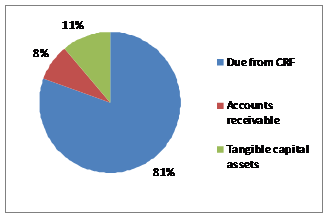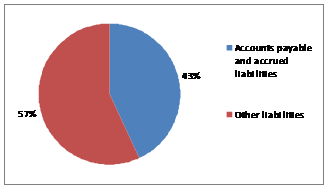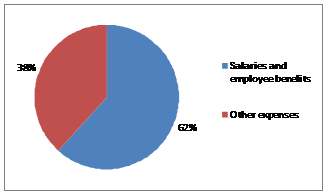Common menu bar links
Breadcrumb Trail
ARCHIVED - Copyright Board of Canada - Report
 This page has been archived.
This page has been archived.
Archived Content
Information identified as archived on the Web is for reference, research or recordkeeping purposes. It has not been altered or updated after the date of archiving. Web pages that are archived on the Web are not subject to the Government of Canada Web Standards. As per the Communications Policy of the Government of Canada, you can request alternate formats on the "Contact Us" page.
SECTION III: SUPPLEMENTARY INFORMATION
Financial Highlights
The future-oriented financial highlights presented within this Report on Plans and Priorities are intended to serve as a general overview of the Copyright Board of Canada's financial position and operations. These future-oriented financial highlights are prepared on an accrual basis to strengthen accountability and improve transparency and financial management.
Future-oriented financial statements can be found on the Board's website at:
www.cb-cda.gc.ca.
| Condensed Future Oriented Statement of Financial Position (unaudited) At March 31 |
|||
| (in thousands of dollars) | % Change | Estimated Results 2010-11 |
Forecast 2011-12 |
|---|---|---|---|
| Assets | |||
| Due from the Consolidated Revenue Fund | 8% | 207 | 223 |
| Accounts Receivable and Advances | -26% | 31 | 23 |
| Tangible Capital Assets | -26% | 42 | 31 |
| TOTAL | -1% | 280 | 277 |
| Liabilities | |||
| Accounts Payable and Accrued Liabilities | 3% | 238 | 246 |
| Other Liabilities | 0% | 324 | 324 |
| Total Liabilities | 1% | 562 | 570 |
| Equity | 4% | (282) | (293) |
| TOTAL | -1% | 280 | 277 |
| Condensed Future-oriented Statement of Operations (unaudited) For the period ended March 31 |
|||
| (in thousands of dollars) | % Change | Estimated Results 2010-11 |
Forecast 2011-12 |
|---|---|---|---|
| Expenses | |||
| Salaries and employee benefits | 1% | 2,134 | 2,148 |
| Other expenses | 0% | 1,335 | 1,335 |
| NET COST OF OPERATIONS | 0% | 3,469 | 3,483 |
Assets by type
 |
It is projected that total assets will be valued at $277,000 in fiscal year 2011-12. This is composed of amount due from Consolidated Revenue Fund (81% or $223,000), tangible capital assets (11% or $31,000) and accounts receivable (8% or $23,000). |
Liabilities by type
 |
It is projected that total liabilities will be $570,000 for fiscal year 2011-12. This is mostly made up of vacation pay and severance benefits (57% or $324,000) and accounts payable and accrued liabilities (43% or $246,000). |
Expenses by type
 |
For fiscal year 2011-12, it is projected that total expenses will be $3.5 million. Most of these expenses are made up of salaries and employee benefits (62% or $2.2 million), and operating expenses (38% or $1.3 million). The majority of these latter expenses are required for the Board's policy role. The balance is made up of expenses associated with internal services. |
SECTION IV: OTHER ITEMS OF INTEREST
Organizational Information
Board Members
Board members are appointed by the Governor in Council to hold office during good behaviour for a term not exceeding five years. They may be reappointed once.
The Act requires that the Chairman must be a judge, either sitting or retired, of a superior, county or district court. The Chairman directs the work of the Board and apportions its caseload among the members.
The Act also designates the Vice-Chairman as Chief Executive Officer of the Board. He or she exercises direction over the Board and supervises its staff.
The organizational structure of the Board follows the requirements set out in section 66 and following sections of the Act.
Board's Staff
The Board has a staff of sixteen employees, organized around five operational groups:
- The Registrar, which plans and manages all activities and resources related to public hearings, and the issuing of licences for the use of works whose copyright owners cannot be located, which includes receiving, organizing and reviewing the documentary evidence and information, and organizing and maintaining the Board's records, archives and library.
- The Research and Analysis group, which is responsible for the preparation and analysis of reports and research papers, the development of scenario analysis and recommendations and the provision of economic support to Board members and for decisions.
- The Legal Analysis group, which provides legal analysis and advice on tariff and licence applications before the Board, and represents the Board before the Courts in matters involving its jurisdiction.
- The Corporate Services group, which is responsible for financial and materiel management policies, systems, processes and standards which are consistent with modern comptrollership.
- The Technical Support group, which provides support in particular in respect of informatics.
